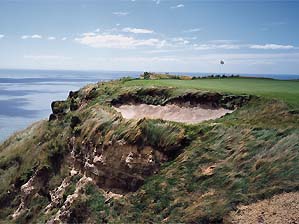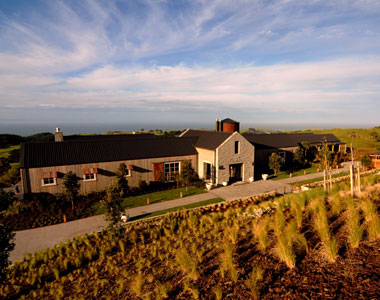 To wander a golf course at night is an exercise in solitude. Though the acres are wide open, the midnight blue closes in and surrounds you, limiting your vision and your sense of space to feet, not yards. While streaks of moonlight splatter the leaves of trees with dabs of ghostly white, any hardwoods or conifers that line the fairways seem like the towering velvet drapes of a darkened theatre. Your hands grasp at the air in front of you to divine a direction, and any sounds, be they the birds or the breeze, seem to sing in stereo to your heightened sense of awareness. But more than anything, it’s your footwork that will ground you and guide you. As you walk, every step you take provides instant feedback through your shoes. Every subtle change of terrain – elevation variations and changes of texture – will be told to you first by your feet. The hillocks and moguls speak to your soles. It’s your toes that first feel the longer grass, tickling fescue, or tangled rough growing from the ground.
To wander a golf course at night is an exercise in solitude. Though the acres are wide open, the midnight blue closes in and surrounds you, limiting your vision and your sense of space to feet, not yards. While streaks of moonlight splatter the leaves of trees with dabs of ghostly white, any hardwoods or conifers that line the fairways seem like the towering velvet drapes of a darkened theatre. Your hands grasp at the air in front of you to divine a direction, and any sounds, be they the birds or the breeze, seem to sing in stereo to your heightened sense of awareness. But more than anything, it’s your footwork that will ground you and guide you. As you walk, every step you take provides instant feedback through your shoes. Every subtle change of terrain – elevation variations and changes of texture – will be told to you first by your feet. The hillocks and moguls speak to your soles. It’s your toes that first feel the longer grass, tickling fescue, or tangled rough growing from the ground.
It’s the utter darkness that alights all of your other senses.
And this is how Tom Doak “sees” a golf course in broad daylight – with the heightened spatial awareness, sensitivity to subtlety, and directional certainty of a talented golf course architect.
Doak doesn’t design new golf courses – he goes looking for them. He feels around for them and then, like a sorcerer or a shaman, he connects with the great spirit of the sod. He then summons the golf courses to rise from the earth and make themselves known to those who might challenge them. Like a horse whisperer, Doak is a course whisperer.
“I’ve got this reputation for being a minimalist and not moving any more earth in the construction process than necessary, so if it’s a really special piece of property to build a golf course on, people tend to look to me,” says Doak, 50, who designed golf courses near wine growing regions of New Zealand, Australia, Michigan and Oregon. “The guys that work for me during the design process know that sometimes I want to get away from them and just walk around by myself and think and stare at the land. That’s when I come up with a good idea.”
Doak and his small team of seven design associates and architects operate Renaissance Golf out of a small house in Traverse City, Michigan, adjacent to the state’s burgeoning wine region, which counts Black Star Farms, Chateau Chantal, Leelanau Cellars, and Ciccone – owned by pop star Madonna’s family – among the 25 wineries and vineyards in the immediate area. Doak’s first course, High Pointe, is right down the road.�
Away from home, Doak’s team has been putting their feet and handiwork on some of the world’s choicest pieces of land:
-The remote Oregon coast, where, in 2001, he set the golf world on its ear by designing Pacific Dunes, near the Umpqua, Rogue and Applegate Valley wine regions south of Eugene. Pacific Dunes, the star of a four-course Mecca called Bandon Dunes Resort, is a seaside links course which rocketed to near the top of the golf course rankings.

It began in 1999 with the opening of Bandon Dunes’ original course. Designed by Scotsman David McLay Kidd, the course is perched on a bluff high above the Pacific Ocean. Bandon Dunes unfolds along pristine native dunes where expansive ocean views are revealed on nearly every hole. The course is completely natural and routed through an environment of indigenous vegetation. Beyond breathtaking scenery lies the game of golf in its truest form – a thinker’s course. Winds are ever-present, and the varying elements create a new experience each time you play.
When Bill Coore and Ben Crenshaw began working in the sand to uncover the third course, Bandon Trials, in 2005, they faced the challenge of following Bandon and Pacific Dunes. Bandon Trails begins atop a massive sand dune, quickly opens into a sprawling meadow, works higher into the coastal forest, and finally returns to finish in the dunes. Bandon Trails is a reminder of how the game was originally created among inland rolling dunes with dramatic ocean vistas.

But it was Doak’s Pacific Dunes opened in 2001 and is remarkably different in character and shot making requirements than the other courses at Bandon Dunes. Pacific Dunes doesn’t feel like it was built as much as it was discovered. Rippling fairways remain just as they were found and natural bunkers line the landscape as they have for centuries. The course emerges from shore pines to spectacular 60-foot sand dunes. When the wind blows, precise approach shots are a necessity, because Pacific Dunes is short enough to give you hope, but rugged enough to test every facet of your game.
1.PEBBLE BEACH G. LINKS
Pebble Beach—800-654-9300; pebblebeach.com
2.PINEHURST RESORT & C.C. (No. 2)
Pinehurst, N.C.—800-487-4653; pinehurst.com
3.SHADOW CREEK
North Las Vegas, Nev.—866-260-0069; shadowcreek.com
4.PACIFIC DUNES
Bandon, Ore.—888-345-6008; bandondunesgolf.com
5.WHISTLING STRAITS G.C. (Straits)
Haven, Wis.—800-618-5535; whistlingstraits.com
6.BANDON DUNES
Bandon, Ore.—888-345-6008; bandondunesgolf.com
7.BETHPAGE STATE PARK G. CSE. (Black)
Farmingdale, N.Y.—516-249-4040; nysparks.state.ny.us
8.THE OCEAN COURSE
Kiawah Island, S.C.—888-854-2924; kiawahgolf.com
9.SPYGLASS HILL G. CSE.
Pebble Beach—800-654-9300; pebblebeach.com
10.ARCADIA BLUFFS G.C.
Arcadia, Mich.—800-494-8666; arcadiabluffs.com
How did Doak get to create the second course at Bandon Dunes?
“Several friends of mine knew developer and greeting card magnate Mike Kaiser who was the owner of the property. Mike is from Chicago and he was building a course in Oregon because it was the best piece of land he could find to build a course: sand dunes on a 100-foot cliff overlooking the ocean,” says Doak. “It doesn’t get much better than that. I’m still amazed they got permits to build golf courses out there, but the land was covered with gorse – the same stuff you see in Scotland, that somebody had brought to the West Coast and it spread like wildfire. It’s a fire hazard and weedy, so their pitch to the environmentalists was that they were going clear the gorse off and plant native grasses and plants and control the rampant spread of gorse. So they got permits to do a couple of golf courses.”
Doak will be finished creating Bandon Dunes’ fourth course – Old Macdonald – in June 2010. The layout is a tribute to Charles Blair Macdonald (1856-1939), the father of American golf course architecture and founder of the U.S. Golf Association. Designed by Tom Doak and his colleague Jim Urbina, Old Macdonald will feature the classic principles and strategies that Macdonald incorporated into his own courses, chiefly National Golf Links of America in Southampton, New York.

90 miles inland, the modern era of grape growing in Oregon began in the Umpqua Valley with the first commercial planting of fine wine grapes northwest of Roseburg in 1961. Today, 19 family-owned artisan wineries are creating wines of distinctive quality and character that are receiving international acclaim for the Umpqua Valley.
The complex topography of the Umpqua Valley, formed by the convergence of three mountain ranges of varying ages and structure, contributes to the occurrence of varied soil types and the many sub-valleys known as the Hundred Valleys of the Umpqua. The rich diversity of landscapes and climates provide a wide range of conditions needed to produce an exciting array of grape varieties. The cooler valleys allow varietals such as Pinot Noir, Pinot Gris, and Riesling to flourish while the warmer valleys include Merlot, Cabernet, Syrah, Tempranillo, and Grenache. Overall, the Umpqua Valley is Oregon’s most complex wine growing region.
Thunderous waterfalls, covered bridges, wildlife viewpoints, make the Umpqua Valley an idyllic natural destination.

Oregon’s oldest vineyard and winery, HillCrest Vineyard, was established in 1961. Family owned and operated, HillCrest specializes in small lot wines handcrafted from the state’s oldest vineyards. These hillside vineyard sites, with their low yielding, dry farmed vines, are naturally grown allowing the wines to develop their own unique personality and character. Gentle, gravity flow winemaking techniques and a hands-off approach allows the perfume and supple texture of the wines to be captured. The family members are involved in every aspect of HillCrest Vineyard from rooting and grafting the vines, to winemaking and sharing the wines in the tasting room.
Southern Oregon’s diverse and exciting Rogue Valley and Applegate Valley AVAs are also easily within reach. Until early 2001, the two appellations were defined as one… the Rogue Valley American Viticultural Area (AVA). The Applegate Valley gained federal authorization that year as a separate Oregon AVA, although it lies entirely within the Rogue Valley AVA and both are entirely within the newer Southern Oregon AVA.

Three river valleys adjoin one another and their namesake rivers drain the Siskiyou Mountains in the south (along the California border) to the Rogue River in the north on its way to the Pacific Ocean. These three valleys – from east to west, Bear Creek Valley, Applegate Valley and the Illinois Valley – together define roughly the boundaries of the Rogue Valley AVA.
Overall, the annual “heat units” in this portion of Oregon State far exceed those in the northern wine regions of Oregon. For viticulturists, viniculturists and wine enthusiasts alike, this means heat-loving varietals thrive in Southern Oregon: Cabernet Sauvignon, Merlot, Cabernet Franc and Syrah. The cooler Illinois Valley to the west, however, allows for successful cooler climate viticulture, much like the Willamette Valley.
The warmest and driest of the three valleys in the Rogue region – Bear Creek Valley – runs parallel with the I-5 corridor. Bear Creek Valley’s climate is similar to France’s Bordeaux region and is well suited for growing highly prized grape varieties including Cabernet Sauvignon, Merlot, Chardonnay, Cabernet Franc, Pinot Gris, Sauvignon Blanc, Malbec and Syrah.�
South of Grants Pass and east of Bear Creek Valley is the historic the Applegate Valley, one of Oregon’s newest appellations. Stretching out along the path of the Applegate River, the valley’s more moderate climate is generally drier and warmer than the Illinois Valley to its west, yet not as warm and dry as Bear Creek Valley to the east. Its vineyards are planted to Bordelaise varieties such as Merlot, Cabernet Sauvignon, Syrah, Chardonnay and Zinfandel.
To the west of the Applegate Valley appellation, and still within the Rogue Valley Appellation, the Illinois Valley is furthest of the three valleys from primary population areas. Mirroring the course of the Illinois River (and its tributaries through the Cave Junction area), the Illinois Valley carves its path through the forested mountains of the Siskiyou to the south and the Klamath to the west. High elevation and a marine influence, spilling over the coastal mountains to the west, are major elements of this valley’s distinct terroir. These influences make the Illinois Valley’s micro climate suitable for growing high-quality Burgundian varieties such as Pinot Noir, Gewürztraminer, Riesling, Pinot Gris, Chardonnay, Pinot Blanc, early Muscat and Gamay Noir.
The Willamette Valley is 150 miles long and 60 miles wide and contains the broad Willamette River and its tributaries. Tucked between the Coast Range to the west and the Cascade Range to the east, its approximate northern and southern borders are Portland and Eugene.

As Oregon’s most accredited American Viticultural Area, with no fewer than six sub-appellations, the Willamette Valley is home to nearly 300 wineries, many of them famous as producers of Pinot Nior – a grape which requires a balance of daytime heat and nighttime chill in order to develop into one of the most revered and prized wines in the world.
SIDEBAR on “SIDEWAYS”
“Miles’” Ode to Pinot Nior from the motion picture “Sideways”
“It’s a hard grape to grow. As you know, it is thin-skinned, temperamental, ripens early. It’s not a survivor like cabernet that can grow anywhere and thrive even when neglected. Pinot needs constant care and attention and in fact can only grow in specific little tucked-away corners of the world. And only the most patient and nurturing growers can do it, really can tap into pinot’s most fragile, delicate qualities. Only when someone has taken the time to truly understand its potential can pinot be coaxed into its fullest expression. And when that happens, its flavors are the most haunting and brilliant and subtle and thrilling and ancient on the planet.”
-Doak’s Cape Kidnappers Golf Club, on the east coast of New Zealand’s north island, is built on breathtaking fingers of seafront land just around the coast and 140 meters above the town of Napier, in Hawke’s Bay – 360 km south of Auckland. Completed in 2004, Cape Kidnappers, par 71, 7,119 yards, ranks among the world’s Top 100 and plays over the tops of tea trees and along dramatic ravines on the site of a working sheep farm, which is still visible from the course and gives the clubhouse and luxury lodge its theme.

“Developer Julian Roberts played Pacific Dunes the day after it opened and thought it was pretty good,” Doak explains. “He called me and asked me if I’d like to do a course in New Zealand. Cape Kidnappers was the result. Where Pacific Dunes is 100 feet above the ocean, Cape Kidnappers is 600 feet above the ocean. It’s hard to describe. The pictures of the place don’t even do it justice. It was a fabulous experience to get to go there for a couple of months and build something really cool.”
Doak, typically deadpan, becomes animated when talking about Cape Kidnappers, because it truly is a one-of-a-kind golf experience.
“If you stray on your approaches, you’ll actually hope to get caught up in bunkers hanging off the green’s edge, some of them deeper than you’ve ever seen before,” says Doak. “Three times, you’ll have to make the perilous leap from the end of one ridge to the end of the next. And at the sixth and fifteenth holes it’s possible to pull your approach off the very end of the earth, though it will take nearly ten seconds of hang time for your ball to reach the ocean below.”
The course is firm and fast – not technically a links course, but largely treeless and windswept. The terrain rolls, rises and falls, and some of the holes are decidedly spartan and simple, especially the 460-yard, par-four, 12th, named “Infinity” because the back of the green seems to play off of the world, which it literally does: 600 feet down to the bay.
A white-knuckle bridge over a deep crevice leads players to the 348-yard, 14th hole, the shortest par-four on the course, but, Doak warns, perhaps the most dangerous.
“Be especially careful around this green as the pot bunker has a gravitational pull far greater than its’ size.”
Doak called visiting the region to create and build Cape Kidnappers a thrill. “It was a great adventure to track up the hill every day and build a golf course in such a remarkable setting.”
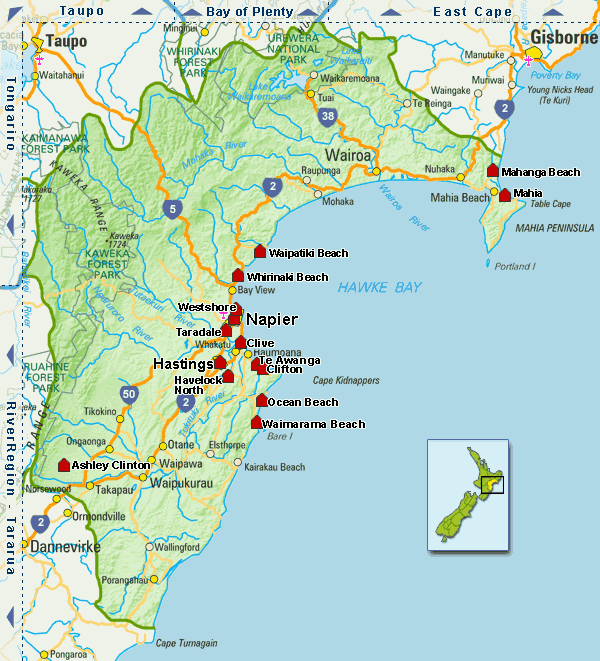
The wines of Hawkes Bay are, by estimation, also remarkable. The region, which has been producing gapes for 150 years, features more than 60 wineries harvesting on a spread of microclimates and soil types. High summer temperatures in a maritime climate, clean water, a varying landscape, and low rainfall give New Zealand’s second-largest wine region a stunning range of varietals and quality red wines and complex Chardonnays.
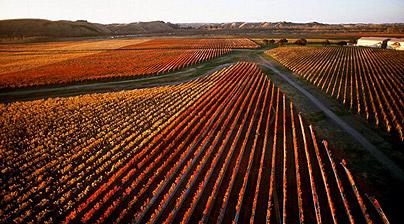
“It’s a treat to find a region that is able to produce red wines that have the full ripeness without the levels of excess common to Australian and Napa Valley wines. There’s a sturdy intensity but I like the restraint shown here in Hawkes Bay,” said Patrick Comiskey, a senior correspondent for Wine & Spirit Magazine US. Comiskey is a regular contributor to the Los Angeles Times and San Francisco Chronicle. “I’m especially charmed by the Chardonnays. What I’ve tasted is luscious, with a generous sexy mouth feel that’s energetic and refreshing.”
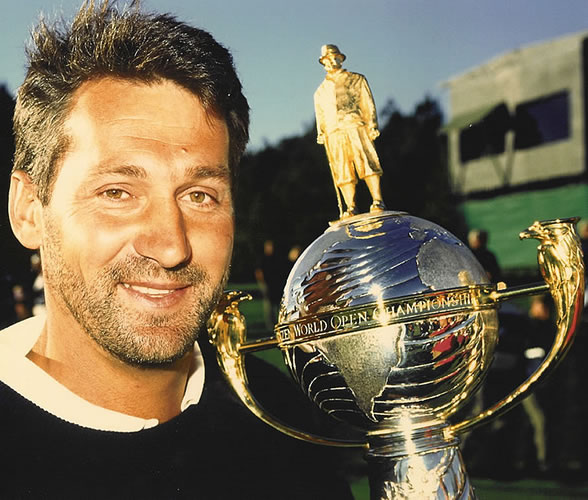
Frank Nobilo, one of the golf most famous players – and now a television announcer – represents one of Hawkes Bay’s most respected wine brands: Nobilo Wines. Noblio played in three Presidents Cup Matches and won 14 times around the world – including the 1997 Greater Greensboro Chrysler Classic on the US PGA Tour. He is now a television commentator for the Golf Channel and is related to the brand’s late founder Nicolai Nobilo.
“I’ve always been passionate about Nobilo wines because of their tremendous quality and how they capture the essence of New Zealand which will always be my home,” said Nobilo, a native of Auckland, who serves as a Brand Ambassador for the wine company.
The history of the company in New Zealand goes back to the early 1940’s when Nikola Nobilo, a pioneer whose family’s winemaking history stretches back over 300 years in Europe, effectively persuaded the New Zealand wine industry away from hybrid grape varieties and fortified wines to a higher level of quality wine. Nobilo’s Hawkes Bay wines include Merlot, Chardonnay, Cabernet Sauvignon and Syrah.
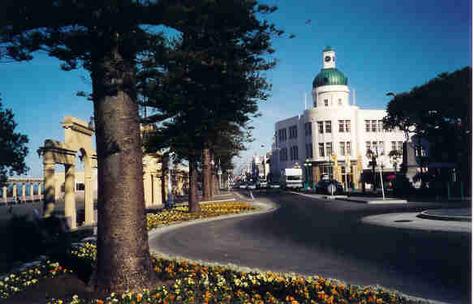
Napier is a scenic, walkable, waterfront little Art Deco-styled town (recreated in 1931 after a major earthquake) with an old-fashioned feel yet a plunky, contemporary nightlife and charming boutique hotels. 15-minutes’ drive from the town center lies Taradale, home to the Mission Estate Winery – New Zealand’s oldest winemaker and Hawkes Bay’s largest. Established in 1851 on a site that also served as a seminary, the winery offers a sweeping view of Napier.
The neighboring winery, Church Road, features a wine museum.
The New Zealand wine industry began to find its feet in becoming a world player in the 1970’s, when the country began to produce Sauvignon Blanc. The world has swirled its glass, sniffed, tasted, and been astonished ever since. New Zealand Sauvignon Blancs became the benchmark for the varietal: refreshing, bold and full-flavored.
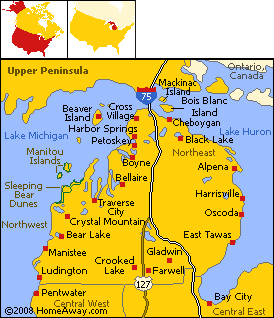
-Northern Michigan, Tom Doak’s home base, is also home to his first two golf course designs: Highpointe Golf Club, near Traverse City; and Black Forest Golf Club, near Gaylord – in the heart of Michigan’s wine country.
Doak is no stranger to travel – he’s been globetrotting since his boyhood in New York, when his father took him along to business conferences, often held at golf resorts. Doak says that it was Pete Dye’s Harbor Town Golf Links on Hilton Head Island which made the biggest impression on him. Thereafter, the enterprising young Doak sent letters to golf club managers and superintendents far and wide asking for the opportunity to come and examine their noted golf courses. Golf course architecture was not as en vogue then as it is today, so he was welcomed at otherwise impenetrable American enclaves such as Medinah, Pine Valley, Oakmont, and Shinnecock Hills.
After one semester at MIT, he bolted for Cornell University, where, while studying landscape architecture, Doak was allowed to create his own curriculum which resulted in a scholarship for an unprecedented post-graduate study: a full year wandering the British Isles and studying the shaping of authentic and antique links courses. By the time he was finished voraciously gobbling up all the golf he could find, Doak had seen, played and photographed more than 1,000 of the world’s great golf courses and unknown charmers. At some stage, fate had whispered two words in his ear: Crystal Downs.
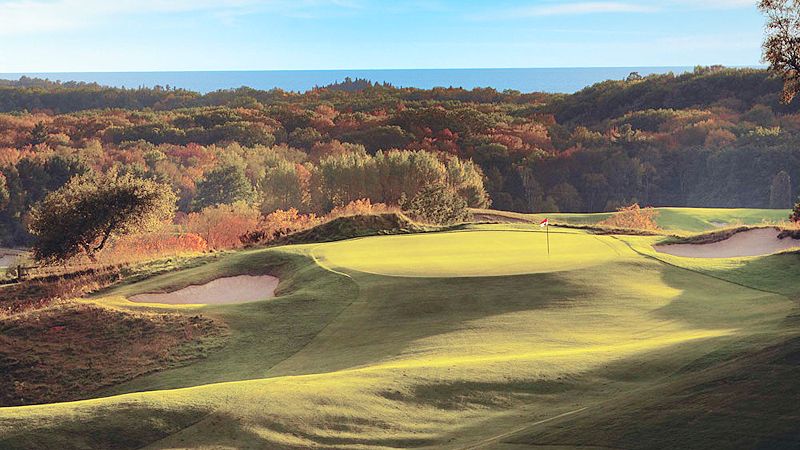
A friend of mine told me it was a great, unheralded golf course, so I came to Northern Michigan to see it,” says Doak of the now acclaimed Alister MacKenzie design in Frankfurt. Doak was, by then, working as an assistant with the famed architect Pete Dye, whose work he had so admired at Harbor Town, but he had become so friendly with Crystal Downs golf professional Fred Muller that he managed to make repeated trips to the quiet, scenic club.
Doak’s career took flight, and Traverse City became his permanent home, when, in 1987, Doug Grove, who was then the head professional at Grand Traverse Resort, was helping to develop a piece of ground on the highway just east of the resort. Grove called Muller to ask whether he knew of any fresh, new golf course architects. Muller recommended Doak and, at age 26, Doak had his first solo design project: High Pointe Golf Club.
“I promised the owners, Hayden Sr. his son Don Jr., that I would live here during construction of the course and do the shaping on the bulldozer as well as the design, so basically I lived here for two years while High Pointe was built,” explains Doak, who received $75,000, plus a $10,000 bonus for the job. More importantly, he learned a valuable lesson about wealth, ego, and vision that would prove to be the business model for Renaissance Golf Design for years to come.
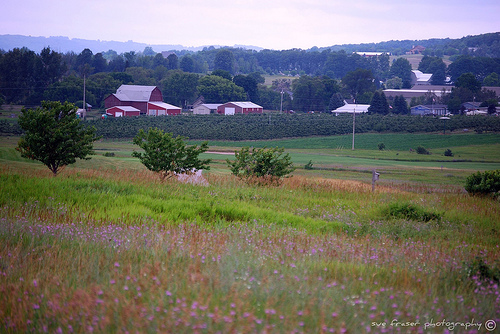
“High Pointe was not developed because there was demand. It was developed because Mr. Hayden owned a beautiful piece of land, loved golf, and always thought it’d be a nice place for a course. He had the money to do it. He looked around and justified that there would be enough demand that he wouldn’t be throwing his money away,” said Doak, who says now that more than half of his clients are similarly motivated.
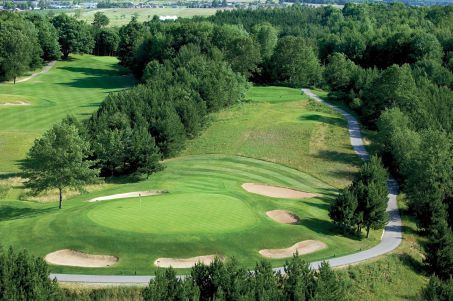
The result, because of the land he was given to work with, was an open front-nine routed in a links style and a back nine that climbed and fell through forested terrain. Doak designed High Pointe in the figurative and literal shadow of The Bear, the much ballyhooed golf course Jack Nicklaus had built for Grand Traverse Resort only a few years earlier. “I don’t like to second guess other architects, but The Bear is an artificial golf course. They try to market it as a Scottish-style golf course but they moved earth to make it look like they thought people thought Scotland looked like,” says Doak. “It’s not that I don’t think The Bear is a good golf course, it’s just not my philosophy of golf at all, so when we started High Pointe, a lot of the decisions I made were because I wanted to do something really different from The Bear. The Bear made it that much easier to pinpoint and say, ‘let’s not do this and not do that. Let’s not build ponds if we can avoid it. Let’s not build a bunch of mounds.’”
High Pointe was well-received, and not long after, Doak was employing a similar contrarian architectural philosophy when he was commissioned to design the Black Forest Golf Course at Wilderness Valley in Gaylord.
“The original course at Wilderness Valley was a simple, 1950’s golf course. When I was hired to add Black Forest there in the late 1980’s, all the new courses in Northern Michigan, such as The Bear and Treetops, made a point in their advertising and marketing of touting how difficult their courses were,” Doak explains. “My client at Wilderness Valley, David Smith, said too many people were coming off of the original course saying it was too easy. ‘I don’t want to hear that about your course,’ he instructed me. So, whatever Black Forest is, it is not ‘too easy.’”
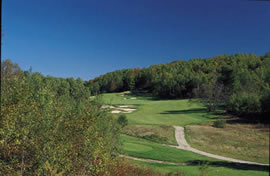
Doak is like a winemaker, in some ways. He likes to be there and involved when his vintage courses mature.
“Once I’m done with my work, the golf courses grow up on their own. The client owns them and a superintendent manages them. They’re living things that grow over time, and they don’t all evolve the same way. Some evolve or the better – some for the worse, some just different,” says Doak. “High Pointe was especially difficult for me because it was my first love. I spent two years working on it so I was very emotionally wrapped up in it and I didn’t know how to let go. The owners had not been in the golf business before, so they asked my advice about some operational things, but I didn’t know when to stop telling them their business. So, at some point, we had a falling out and I just had to watch what they were doing and not say anything one way or another.”
Doak says he’s on better terms with High Pointe’s owners now that he’s recognized worldwide in the golf architecture business.
“Having grown up and matured helps too. I was 26 when we built High Pointe. I’m 45 now. There’s a difference.”
Doak says the best way for people to know if they’ve played a good golf course is whether or not they had fun and want another crack at it.
“I’ve always felt I thought more about the average guy – I try to not put things out there that are completely frustrating for them. I don’t ensure they shoot a good score, but I want to make sure they can get around.”
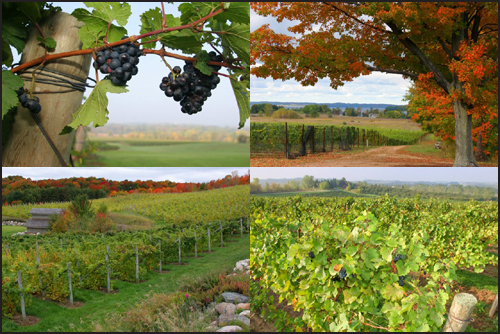
The modern Michigan wine industry is built upon two major grape types. Hybrid varieties, sometimes called French-American hybrids, produce good quality table wines and are also cold-hardy and disease-resistant. With names like Vignoles and Chambourcin, hybrids deserve to be better known than they are. The other type includes traditional European varieties such as Chardonnay and Merlot. These European varieties are often referred to by their scientific name – vitis vinifera.
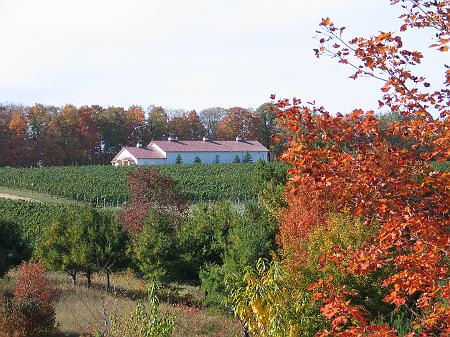
In the late 1950s and early 1960s, the first hybrid grape varieties were introduced into Southwest Michigan. The first European varieties were planted around 1970 on Mt. Tabor in Berrien County by Len Olsen and Carl Banholzer. Tabor Hill Vineyard and Winery still produces excellent wines from some of these original vines. Southwest Michigan continues to produce large amounts of juice grapes – enough to make Michigan the fourth largest grape-growing state. But this area also produces about half of Michigan’s wine grapes. Growers here have found that wine grapes can be extremely profitable, and they are increasingly ready to plant and properly care for the more tender but valuable hybrid and vinifera varieties.
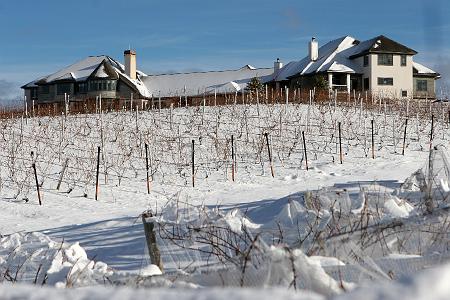
In the 1970s, an entirely new wine region was born in northwest lower Michigan near Traverse City. On the Leelanau Peninsula, Bernie Rink planted the first French-American hybrid vines. Larry Mawby, Bruce Simpson and others soon followed. Over on the Old Mission Peninsula, Ed O’Keefe became convinced – contrary to all accepted wisdom – that Riesling and other vinifera varieties could also be grown. He was proven correct. Today, both the Leelanau and Old Mission peninsulas are predominantly vinifera grape regions. Riesling, Chardonnay, Pinot Noir, Merlot, Cabernet Franc, Gewurztraminer, Pinot Gris and Pinot Blanc all vie for attention. And the number of wineries in the area has increased from an original five to over sixteen and continues to grow.
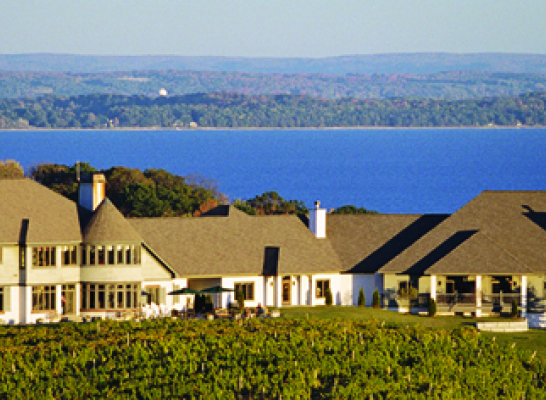
Chateau Chantal Winery and Bed & Breakfast, is only 20 miles from Doak’s Highpointe. With stunning views of East and West Grand Traverse Bays, this development blends a winery, vineyard, bed and breakfast, residence and six private homesites into a retreat to the Old World. The acreage is planted with Chardonnay, Pinot Gris, Pinot Noir, Merlot, Riesling and Gew rztraminer, along with a Pinot Meunier for a champagne blend.
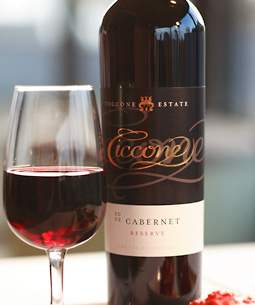
Ciccone Family Vineyard, owned by Madonna’s family, sits in panoramic view of West Grand Traverse Bay and the rolling hills of Leelanau. Pinot Grigio, Gewurztraminer, Cabernet Franc, Dolcetto, Chardonnay, Pinot Noir, Cabernet Sauvignon, Malbec, and Merlot embrace the landscape.
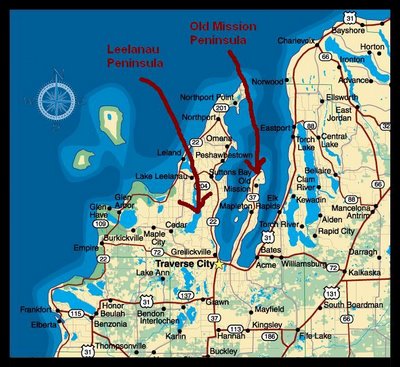
A short drive along scenic M-37, among the rolling hills and sublime views of East Grand Traverse Bay, sits Black Star Farms Old Mission. Once home to locally reknowned Underwood Farm Market, the site now houses a beautifully renovated tasting room and state of the art winemaking facility.
The tasting room boasts a full round bar constructed from nine oak wine barrels, a cozy fireplace, and wine proudly on display. Blackstar produces a specialized list of varietal and cherry wines – all made with at least 85% of grapes or fruit grown on Old Mission Peninsula.
–MPS


